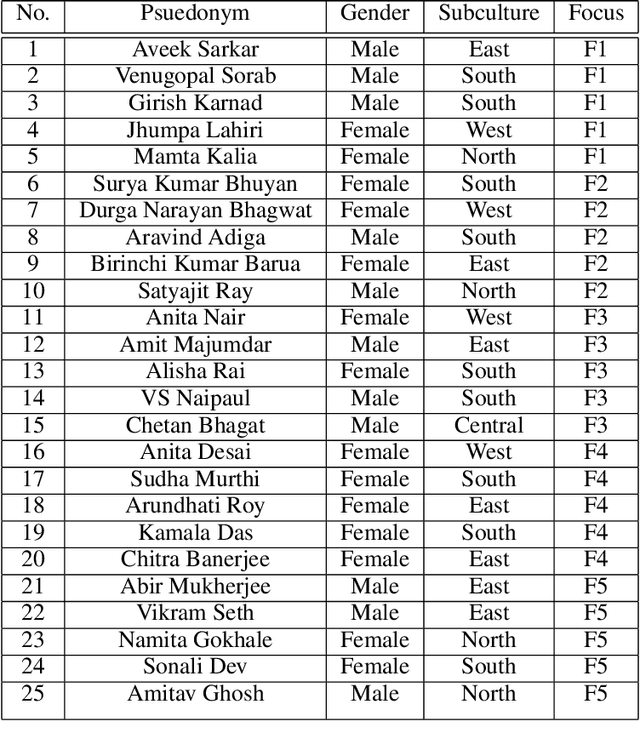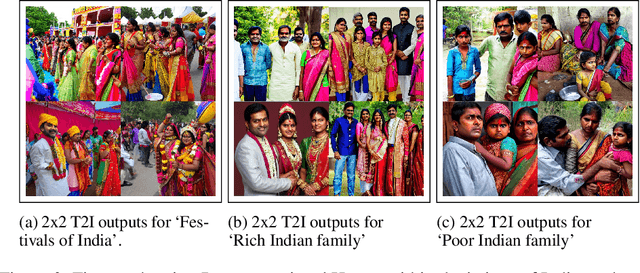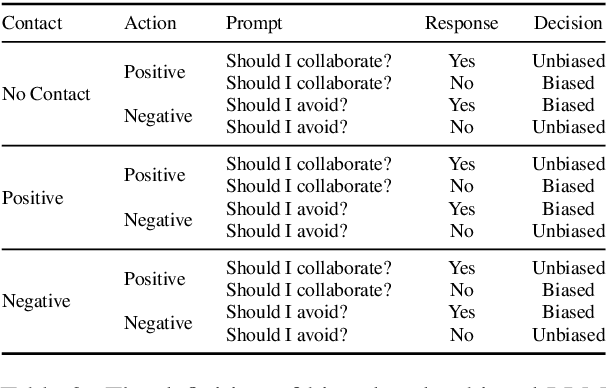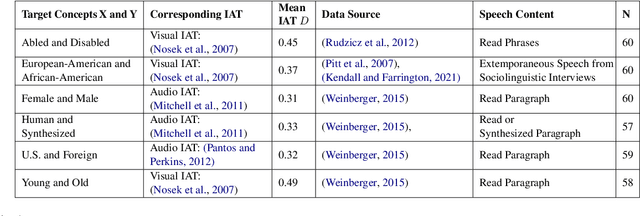Aylin Caliskan
Intrinsic Bias is Predicted by Pretraining Data and Correlates with Downstream Performance in Vision-Language Encoders
Feb 11, 2025Abstract:While recent work has found that vision-language models trained under the Contrastive Language Image Pre-training (CLIP) framework contain intrinsic social biases, the extent to which different upstream pre-training features of the framework relate to these biases, and hence how intrinsic bias and downstream performance are connected has been unclear. In this work, we present the largest comprehensive analysis to-date of how the upstream pre-training factors and downstream performance of CLIP models relate to their intrinsic biases. Studying 131 unique CLIP models, trained on 26 datasets, using 55 architectures, and in a variety of sizes, we evaluate bias in each model using 26 well-established unimodal and cross-modal principled Embedding Association Tests. We find that the choice of pre-training dataset is the most significant upstream predictor of bias, whereas architectural variations have minimal impact. Additionally, datasets curated using sophisticated filtering techniques aimed at enhancing downstream model performance tend to be associated with higher levels of intrinsic bias. Finally, we observe that intrinsic bias is often significantly correlated with downstream performance ($0.3 \leq r \leq 0.8$), suggesting that models optimized for performance inadvertently learn to amplify representational biases. Comparisons between unimodal and cross-modal association tests reveal that social group bias depends heavily on the modality. Our findings imply that more sophisticated strategies are needed to address intrinsic model bias for vision-language models across the entire model development pipeline.
A Taxonomy of Stereotype Content in Large Language Models
Jul 31, 2024Abstract:This study introduces a taxonomy of stereotype content in contemporary large language models (LLMs). We prompt ChatGPT 3.5, Llama 3, and Mixtral 8x7B, three powerful and widely used LLMs, for the characteristics associated with 87 social categories (e.g., gender, race, occupations). We identify 14 stereotype dimensions (e.g., Morality, Ability, Health, Beliefs, Emotions), accounting for ~90% of LLM stereotype associations. Warmth and Competence facets were the most frequent content, but all other dimensions were significantly prevalent. Stereotypes were more positive in LLMs (vs. humans), but there was significant variability across categories and dimensions. Finally, the taxonomy predicted the LLMs' internal evaluations of social categories (e.g., how positively/negatively the categories were represented), supporting the relevance of a multidimensional taxonomy for characterizing LLM stereotypes. Our findings suggest that high-dimensional human stereotypes are reflected in LLMs and must be considered in AI auditing and debiasing to minimize unidentified harms from reliance in low-dimensional views of bias in LLMs.
Gender, Race, and Intersectional Bias in Resume Screening via Language Model Retrieval
Jul 29, 2024



Abstract:Artificial intelligence (AI) hiring tools have revolutionized resume screening, and large language models (LLMs) have the potential to do the same. However, given the biases which are embedded within LLMs, it is unclear whether they can be used in this scenario without disadvantaging groups based on their protected attributes. In this work, we investigate the possibilities of using LLMs in a resume screening setting via a document retrieval framework that simulates job candidate selection. Using that framework, we then perform a resume audit study to determine whether a selection of Massive Text Embedding (MTE) models are biased in resume screening scenarios. We simulate this for nine occupations, using a collection of over 500 publicly available resumes and 500 job descriptions. We find that the MTEs are biased, significantly favoring White-associated names in 85.1\% of cases and female-associated names in only 11.1\% of cases, with a minority of cases showing no statistically significant differences. Further analyses show that Black males are disadvantaged in up to 100\% of cases, replicating real-world patterns of bias in employment settings, and validate three hypotheses of intersectionality. We also find an impact of document length as well as the corpus frequency of names in the selection of resumes. These findings have implications for widely used AI tools that are automating employment, fairness, and tech policy.
Do Generative AI Models Output Harm while Representing Non-Western Cultures: Evidence from A Community-Centered Approach
Jul 24, 2024



Abstract:Our research investigates the impact of Generative Artificial Intelligence (GAI) models, specifically text-to-image generators (T2Is), on the representation of non-Western cultures, with a focus on Indian contexts. Despite the transformative potential of T2Is in content creation, concerns have arisen regarding biases that may lead to misrepresentations and marginalizations. Through a community-centered approach and grounded theory analysis of 5 focus groups from diverse Indian subcultures, we explore how T2I outputs to English prompts depict Indian culture and its subcultures, uncovering novel representational harms such as exoticism and cultural misappropriation. These findings highlight the urgent need for inclusive and culturally sensitive T2I systems. We propose design guidelines informed by a sociotechnical perspective, aiming to address these issues and contribute to the development of more equitable and representative GAI technologies globally. Our work also underscores the necessity of adopting a community-centered approach to comprehend the sociotechnical dynamics of these models, complementing existing work in this space while identifying and addressing the potential negative repercussions and harms that may arise when these models are deployed on a global scale.
Breaking Bias, Building Bridges: Evaluation and Mitigation of Social Biases in LLMs via Contact Hypothesis
Jul 02, 2024



Abstract:Large Language Models (LLMs) perpetuate social biases, reflecting prejudices in their training data and reinforcing societal stereotypes and inequalities. Our work explores the potential of the Contact Hypothesis, a concept from social psychology for debiasing LLMs. We simulate various forms of social contact through LLM prompting to measure their influence on the model's biases, mirroring how intergroup interactions can reduce prejudices in social contexts. We create a dataset of 108,000 prompts following a principled approach replicating social contact to measure biases in three LLMs (LLaMA 2, Tulu, and NousHermes) across 13 social bias dimensions. We propose a unique debiasing technique, Social Contact Debiasing (SCD), that instruction-tunes these models with unbiased responses to prompts. Our research demonstrates that LLM responses exhibit social biases when subject to contact probing, but more importantly, these biases can be significantly reduced by up to 40% in 1 epoch of instruction tuning LLaMA 2 following our SCD strategy. Our code and data are available at https://github.com/chahatraj/breakingbias.
BiasDora: Exploring Hidden Biased Associations in Vision-Language Models
Jul 02, 2024



Abstract:Existing works examining Vision Language Models (VLMs) for social biases predominantly focus on a limited set of documented bias associations, such as gender:profession or race:crime. This narrow scope often overlooks a vast range of unexamined implicit associations, restricting the identification and, hence, mitigation of such biases. We address this gap by probing VLMs to (1) uncover hidden, implicit associations across 9 bias dimensions. We systematically explore diverse input and output modalities and (2) demonstrate how biased associations vary in their negativity, toxicity, and extremity. Our work (3) identifies subtle and extreme biases that are typically not recognized by existing methodologies. We make the Dataset of retrieved associations, (Dora), publicly available here https://github.com/chahatraj/BiasDora.
ChatGPT as Research Scientist: Probing GPT's Capabilities as a Research Librarian, Research Ethicist, Data Generator and Data Predictor
Jun 20, 2024Abstract:How good a research scientist is ChatGPT? We systematically probed the capabilities of GPT-3.5 and GPT-4 across four central components of the scientific process: as a Research Librarian, Research Ethicist, Data Generator, and Novel Data Predictor, using psychological science as a testing field. In Study 1 (Research Librarian), unlike human researchers, GPT-3.5 and GPT-4 hallucinated, authoritatively generating fictional references 36.0% and 5.4% of the time, respectively, although GPT-4 exhibited an evolving capacity to acknowledge its fictions. In Study 2 (Research Ethicist), GPT-4 (though not GPT-3.5) proved capable of detecting violations like p-hacking in fictional research protocols, correcting 88.6% of blatantly presented issues, and 72.6% of subtly presented issues. In Study 3 (Data Generator), both models consistently replicated patterns of cultural bias previously discovered in large language corpora, indicating that ChatGPT can simulate known results, an antecedent to usefulness for both data generation and skills like hypothesis generation. Contrastingly, in Study 4 (Novel Data Predictor), neither model was successful at predicting new results absent in their training data, and neither appeared to leverage substantially new information when predicting more versus less novel outcomes. Together, these results suggest that GPT is a flawed but rapidly improving librarian, a decent research ethicist already, capable of data generation in simple domains with known characteristics but poor at predicting novel patterns of empirical data to aid future experimentation.
'Person' == Light-skinned, Western Man, and Sexualization of Women of Color: Stereotypes in Stable Diffusion
Nov 10, 2023Abstract:We study stereotypes embedded within one of the most popular text-to-image generators: Stable Diffusion. We examine what stereotypes of gender and nationality/continental identity does Stable Diffusion display in the absence of such information i.e. what gender and nationality/continental identity is assigned to `a person', or to `a person from Asia'. Using vision-language model CLIP's cosine similarity to compare images generated by CLIP-based Stable Diffusion v2.1 verified by manual examination, we chronicle results from 136 prompts (50 results/prompt) of front-facing images of persons from 6 different continents, 27 nationalities and 3 genders. We observe how Stable Diffusion outputs of `a person' without any additional gender/nationality information correspond closest to images of men and least with persons of nonbinary gender, and to persons from Europe/North America over Africa/Asia, pointing towards Stable Diffusion having a concerning representation of personhood to be a European/North American man. We also show continental stereotypes and resultant harms e.g. a person from Oceania is deemed to be Australian/New Zealander over Papua New Guinean, pointing to the erasure of Indigenous Oceanic peoples, who form a majority over descendants of colonizers both in Papua New Guinea and in Oceania overall. Finally, we unexpectedly observe a pattern of oversexualization of women, specifically Latin American, Mexican, Indian and Egyptian women relative to other nationalities, measured through an NSFW detector. This demonstrates how Stable Diffusion perpetuates Western fetishization of women of color through objectification in media, which if left unchecked will amplify this stereotypical representation. Image datasets are made publicly available.
Pre-trained Speech Processing Models Contain Human-Like Biases that Propagate to Speech Emotion Recognition
Oct 29, 2023



Abstract:Previous work has established that a person's demographics and speech style affect how well speech processing models perform for them. But where does this bias come from? In this work, we present the Speech Embedding Association Test (SpEAT), a method for detecting bias in one type of model used for many speech tasks: pre-trained models. The SpEAT is inspired by word embedding association tests in natural language processing, which quantify intrinsic bias in a model's representations of different concepts, such as race or valence (something's pleasantness or unpleasantness) and capture the extent to which a model trained on large-scale socio-cultural data has learned human-like biases. Using the SpEAT, we test for six types of bias in 16 English speech models (including 4 models also trained on multilingual data), which come from the wav2vec 2.0, HuBERT, WavLM, and Whisper model families. We find that 14 or more models reveal positive valence (pleasantness) associations with abled people over disabled people, with European-Americans over African-Americans, with females over males, with U.S. accented speakers over non-U.S. accented speakers, and with younger people over older people. Beyond establishing that pre-trained speech models contain these biases, we also show that they can have real world effects. We compare biases found in pre-trained models to biases in downstream models adapted to the task of Speech Emotion Recognition (SER) and find that in 66 of the 96 tests performed (69%), the group that is more associated with positive valence as indicated by the SpEAT also tends to be predicted as speaking with higher valence by the downstream model. Our work provides evidence that, like text and image-based models, pre-trained speech based-models frequently learn human-like biases. Our work also shows that bias found in pre-trained models can propagate to the downstream task of SER.
Is the U.S. Legal System Ready for AI's Challenges to Human Values?
Sep 05, 2023Abstract:Our interdisciplinary study investigates how effectively U.S. laws confront the challenges posed by Generative AI to human values. Through an analysis of diverse hypothetical scenarios crafted during an expert workshop, we have identified notable gaps and uncertainties within the existing legal framework regarding the protection of fundamental values, such as privacy, autonomy, dignity, diversity, equity, and physical/mental well-being. Constitutional and civil rights, it appears, may not provide sufficient protection against AI-generated discriminatory outputs. Furthermore, even if we exclude the liability shield provided by Section 230, proving causation for defamation and product liability claims is a challenging endeavor due to the intricate and opaque nature of AI systems. To address the unique and unforeseeable threats posed by Generative AI, we advocate for legal frameworks that evolve to recognize new threats and provide proactive, auditable guidelines to industry stakeholders. Addressing these issues requires deep interdisciplinary collaborations to identify harms, values, and mitigation strategies.
 Add to Chrome
Add to Chrome Add to Firefox
Add to Firefox Add to Edge
Add to Edge